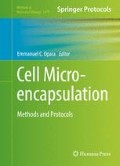Abstract
Allogeneic islet transplantation has become a viable treatment for patients with unstable type 1 diabetes; however, donor shortage and the necessity for immunosuppressive drugs are the major drawbacks of this approach. Microencapsulated porcine islet xenotransplantation could solve these drawbacks. Clinical porcine islet xenotransplantation as well as microencapsulated islet transplantation has been conducted without significant side effects. However, these transplantations are not as efficacious as allogeneic naked islet transplantation. High quality porcine islets, biocompatible capsules, and appropriate implant sites should be the key factors for improving efficacy. With improved efficacy, microencapsulated islet xenotransplantation will solve the major drawbacks associated with current islet transplantation.
Access this chapter
Tax calculation will be finalised at checkout
Purchases are for personal use only
References
The Diabetes Control and Complications Trial Research Group (1997) Hypoglycemia in the Diabetes Control and Complications Trial. Diabetes 46:271–286
Matsumoto S (2010) Islet cell transplantation for type 1 diabetes. J Diabetes 2:16–22
Shapiro AMJ (2012) Islet transplantation in type 1 diabetes: ongoing challenges, refined procedures, and long-term outcome. Rev Diabet Stud 9:385–406
Matsumoto S, Okitsu T, Iwanaga Y et al (2006) Successful islet transplantation from nonheartbeating donor pancreata using modified Ricordi islet isolation method. Transplantation 82:460–465
Matsumoto S, Okitsu T, Iwanaga Y et al (2005) Insulin independence after living-donor distal pancreatectomy and islet allotransplantation. Lancet 365:1642–1644
Groth CG, Korsgren O, Tibell A et al (1994) Transplantation of porcine fetal pancreatic to diabetic patients. Lancet 344:1402–1404
Wang W, Mo Z, Ye B et al (2011) A clinical trial of xenotransplantation of neonatal pig islets for diabetic patients. Zhong Nan Da Xue Xue Bao Yi Xue Ban 36:1134–1140
Valdes-Gonzalez RA, Dornates LM, Garibay GN et al (2005) Xenotransplantation of porcine neonatal islets of Langerhans and Sertoli cells: a 4-year study. Eur J Endocrinol 153:419–427
Valdes-Gonzalez R-VAL, White DJ et al (2010) Long-term follow-up of patients with type 1 diabetes transplanted with neonatal pig islets. Clin Exp Immunol 162:537–542
Elliott RB, Escobar L, Tan PLJ et al (2007) Live encapsulated porcine islets from a type 1 diabetic patient 9.5 yr after xenotransplantation. Xenotransplantation 14:157–161
Calafiore R, Basta G (2014) Clinical application of microencapsulated islets: actual prospective on progress and challenges. Adv Drug Deliv Rev 67–68:84–92
Korbutt GS, Elliott JF, Ao Z et al (1996) Large scale isolation, growth and function of porcine neonatal islet cells. J Clin Invest 97:270–280
Hillberg A, Kathirgamanathan K, Lam JBB et al (2013) Improving alginate-poly-L-ornithine-alginate capsule biocompatibility through genipin crosslinking. J Biomed Mater Res B Appl Biomater 101:258–268
Zhu HT, Lu L, Liu XY et al (2015) Treatment of diabetes with encapsulated pig islets: an update on current developments. J Zhejiang Univ Sci B 16:329–343
Matsumoto S, Tan P, Baker J et al (2014) Clinical porcine islet xenotransplantation under comprehensive regulation. Transplant Proc 46:1992–1995
Soon-Shiong P, Heintz RE, Merideth N et al (1994) Insulin independence in a type 1 diabetic patient after encapsulated islet transplantation. Lancet 343:950–951
Tuch BE, Keogh GW, Williams LJ et al (2009) Safety and viability of microencapsulated human islets transplanted into diabetic humans. Diabetes Care 32:1887–1889
Basta G, Montanucci P, Luca G et al (2011) Long-term metabolic and immunological follow-up of non-immunosuppressed patients with type 1 diabetes treated with microencapsulated islet allografts: four cases. Diabetes Care 34:2406–2409
Hering BJ, Cooper DKC, Cozzi E et al (2009) The international xenotransplantation association consensus statement on conditions for undertaking clinical trials of porcine islet products in type 1 diabetes- Executive summary. Xenotransplantation 16:196–202
Noguchi H, Levy MF, Kobayashi N, Matsumoto S (2009) Pancreas preservation by the two-layer method: does it have a beneficial effect compared with simple preservation in University of Wisconsin solution? Cell Transplant 18:497–503
Qin H, Matsumoto S, Klintmalm GB et al (2011) A meta-analysis for comparison of the two-layer and university of Wisconsin pancreas preservation methods in islet isolation. Cell Transplant 20:1127–1137
Matsumoto S, Noguchi H, Shimoda M et al (2010) Seven consecutive successful clinical islet isolation with pancreatic ductal injection. Cell Transplant 19:291–297
Ricordi C, Lacy PE, Finke EH et al (1988) Automated method for islet isolation of human pancreatic islets. Diabetes 37:413–420
Ricordi C, Socci C, Davalli AM et al (1990) Isolation of the elusive pig islet. Surgery 107:688–694
Krishnan R, Alexander M, Robles L et al (2014) Islet and stem cell encapsulation for clinical transplantation. Rev Diabet Stud 11:84–101
Veiseh O, Doloff JC, Ma M et al (2015) Size- and shape-dependent foreign body immune response to materials implanted in rodents and non-human primates. Nat Mater 14:643–651
Pepper AR, Gala-Lopez B, Pawlick R et al (2015) A prevascularized subcutaneous device-less site for islet and cellular transplantation. Nat Biotechnol 33:518–523
Pareta R, McQuilling JP, Sittadjody S et al (2014) Long-term function of islets encapsulated in a re-designed alginate microcapsule construct in omentum pouch of immune-competent diabetic rats. Pancreas 43:605–613
Author information
Authors and Affiliations
Corresponding author
Editor information
Editors and Affiliations
Rights and permissions
Copyright information
© 2017 Springer Science+Business Media New York
About this protocol
Cite this protocol
Shimoda, M., Matsumoto, S. (2017). Microencapsulation in Clinical Islet Xenotransplantation. In: Opara, E. (eds) Cell Microencapsulation. Methods in Molecular Biology, vol 1479. Humana Press, New York, NY. https://doi.org/10.1007/978-1-4939-6364-5_25
Download citation
DOI: https://doi.org/10.1007/978-1-4939-6364-5_25
Published:
Publisher Name: Humana Press, New York, NY
Print ISBN: 978-1-4939-6362-1
Online ISBN: 978-1-4939-6364-5
eBook Packages: Springer Protocols

